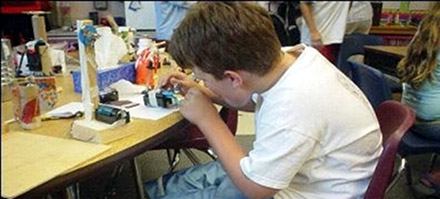
Wk 4: Name Invention

-
The learner will evaluate familiar names of common inventions.
-
The leaner will brainstorm and select a name for his/her invention.
-
Fourth Grade, English Language Arts, Goal 4, Objective 4.03
-
When assessing, the teacher should check the explanation of the name chose. The teacher is looking to see if the student chose a name for a purpose that may or may not include one of the strategies listed during whole group instruction. For example, does the name rhyme, use personification, create a mental picture, etc?
In this lesson, students will design a creative and descriptive name for the invention being designed for the “Invention Convention.” “Invention Convention” is an integrated project combining learning from language arts, science, and math curriculums allowing students to apply their understandings of magnets and electricity by designing or improving an existing invention.
This lesson will require thirty minutes.
-
Student Inventor’s Log
-
Prior to this lesson, students should have completed “Designing Invention” as a part of the “Invention Convention” unit.
-
Place kids in partners and have pairs brainstorm a list of invention names that have caught their attention. Students should record ideas in their “Inventor’s Log.” After kids have had several minutes to work, have them return to a whole group discussion with their Inventor’s Logs.
-
As a class, have students compile a list of inventions with catchy names. Allow students to add any to their lists in their Inventor’s Logs that they particularly like.
-
Some inventions with catchy names could include: Helies’, Dust Buster, New Balance, iPOD, Shaprie, Crayola, Trapper Keeper, Weed Eater, etc.
-
Ask students, “What do you notice about our list?” Students may respond:
Some names hint at jobs, some are personification, some have a rhythm / rhyme, they are easy to remember, they cause you to have an image in your mind, etc. -
Ask students, “Why do you think inventor’s chose these specific names for their inventions when they could have chosen: shoes with wheels, small vacuum, an even shoe, marker with a fine point, secure notebook, etc. Allow students to share their ideas with a partner before sharing with the whole group.
-
Ask students, “When you choose a name for your invention, what should you remember?” Allow students to share their ideas with a partner before sharing with the whole group.
-
Tell students, “Today, you are going to brainstorm and select a name for your invention. Try to keep in mind all of the reasons the names we selected stood out to us. You might even be able to adapt one of these names to fit your invention. Once you have brainstormed several invention names, put a star next to the one you chose. Remember, you should have a reason for choosing the name, so share your reasoning, as well.
-
Allow students to work independently, while dialoging and collaborating with peers.
-
Once everyone is finished, have students share their names and receive compliments from the class. During sharing, students may want to make suggestions or additions to make invention names even better.
-
Because this activity requires manipulation and plays on words, this activity will be particularly difficult for ELLs. To make this task more manageable, ELLs could be allowed to think of a basic, or simple name. From this point, the teacher could assign the ELL a partner to help with creativity, or the class as a whole could help brainstorm creative names.
-
In some cases, it might be appropriate for the student to use their native language for an invention name or to create a bilingual name.
-
This is also an ideal opportunity to teach ELLs rules of capitalization. (Many other languages do not “capitalize all important words” in names and titles, so this skill is not as seemingly simple as it may seem for ELLs.) Teachers should provide examples of places, titles, names, etc, and allow ELLs to look for patterns of words that are capitalized and words that are rarely capitalized. This skill can be applied to the name created for the student’s invention.

